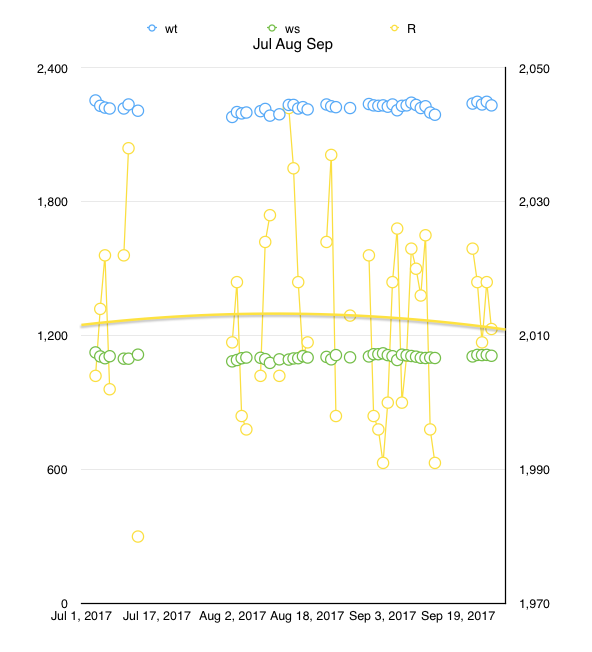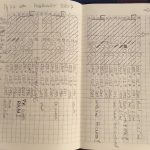(Part 63 of 72 in series, My Journey)
Somewhere in my 30’s, slowly, year by year, the frequency of my back problems increased. I’m not talking about, I helped a friend move over the weekend, or, I did climb-ups for an hour at Parkour class, and now my back is “out.” I’m talking about,
I sat down to put socks on — because I cannot hold my foot up to reach it standing — and my lower back “just” gave out.
or,
I was just standing at the sink washing dishes.
For me, these incidents where I was clearly not doing anything amazing and was still somehow injured, became a clear sign that I needed to change something. In hindsight, this is the article I wish I had found first and so I hope it helps someone.
Elsewhere, in my Changes and Results series, I’m laying out all the big things I’ve changed, project by project. But there was never any one thing that I worked on specifically to fix my back. It simply turned out that many of the things I did contributed to — knock on wood — resolving my back problems. Of course my back still gives me trouble when I deserve it. But these days, I know when it’s going to be a problem. I can feel when my back is getting tired, and if I listen to that quiet signal I can avoid the worst of the problems.
My spine and me
Although I had been doing some intentional, general improvement efforts, such as losing weight and getting better sleep, my back-focused improvement journey really began when I heard Ido Portal say something to the effect of:
Your legs are for moving you through your environment. Your arms are for manipulating your environment. Your spine is for orienting yourself within the environment. So your spine should be this incredibly mobile and powerful system with a huge range of dynamic movement.
(That’s not an exact quote because I don’t feel like going through the entire “Rewild Yourself Podcast” episode where Daniel Vitalis interviewed Ido Portal. It’s episode number 8: Ido Portal on the Movement Diet which you should probably go listen to.)
When I heard that, I realized that my spine was nothing at all like Ido’s vision of a human spine. Mine barely moved at all, and when it did, I often felt nervous about impending disaster. After hearing Ido’s way of describing the spine, I had this new perspective where each time I’d do some movement, I could see how much my spine was right at its limit of ability. I realized that my spine should be an incredibly varied mover, and that my spine’s flexibility (the total movement possible) and range of motion (the smaller space of movement where my back is usable, comfortable and strong) are critical, foundational elements to all of my health and movement.
I realized that for years I had tried to “stabilize” and strengthen my spine as a defense against movement causing injury to my back. But I now see that this is an erroneous reaction to weakness. If instead of being immobilized as a defense, my spine is strong, then it can be mobile, able to make all the movements I need, and not be injured.
Awareness and honesty
The first step was to learn to avoid injury. This sounds trivial, but it was not at all obvious to me at the time. When I was so fat and inflexible that putting my socks on regularly endangered my back, it was a terrible, humbling experience to admit that I had to change how I put my on socks.
I had to identify all the landmines, and own up to them. I had to learn that stretching — really just moving around — was mandatory each morning. I had to stop automatically rushing to help everyone move heavy objects. I had to stop trying to be “the strong guy,” and generally dial down all my activities to a level my back could handle. I had to acknowledge those random days when my back felt “off”, and learn to take a rest day for recovery.
All of which forced me to face that I was no longer indestructible and to own up to the deteriorated state of my body. Awareness and honesty were the only way that I could stop taking frequent steps backwards. They were the only way that I could begin to make glacial forward progress.
(I’ve written more about the Philosophy of the changes I’ve made in my Changes and Results series.)
Weight loss
Losing weight is obviously not easy. But every pound that I peeled off paid dividends to my back. It turns out that weight around your middle drastically increases the load on your lower back. “Lost weight” is a woefully inadequate summary for this element of fixing my back, but hopefully I’ll get around to writing out everything I did to lose weight.
Recovery work
What began as endless massage work by my spouse, slowly morphed into self-massage and then into mobility work; Basically, I learned to lay on the floor moving in all the ways my spine was meant to move. I mastered the use of a foam roller and Lacrosse ball for myofascial release and self-massage. As my back got stronger, I was able expand this recovery practice to a more general, whole-body movement, stretching and — much later — general strengthening.
(I’m writing a separate post on my “20 minutes of morning stretching” which is one of the cornerstones upon which I have built the whole new me. It’s not yet published, but will eventually be part of my Changes and Results.)
Finally, chiropractic has saved me countless times. I know many people who believe chiropractic is quackery. But for me, it doesn’t matter how or why, it simply yields results.
Posture
Years of sitting, and progressive weakening of my back, took their toll. Worse, the hunched back, rolled shoulders posture was so common in my environment, that it seemed normal. So I didn’t even realize what was happening to me.
The first baby step to improving my posture was when I learned how to understand, and control, the orientation of my pelvis through learning to sit as part of martial arts training. The traditional Japanese seated posture, seiza where you sit with folded-under knees and pointed toes is great for learning posture. Of course, this type of sitting initially rewards you with agony from the knees and ankles. But once your legs adapt, there is a delightful feeling of peace and centralized weight when you learn to center your pelvis and to balance and align your entire spine. But maintaining this alignment, even in a statically balanced seated position, required a certain muscle tone. A tone which I had lost through endless sitting in a poor posture.
I soon realized that the orientation of the hands as they hang at your sides is indicative of your upper back posture. Palms turned to the back, (the shoulders being in interior rotation,) with that “knuckle-dragger” appearance is a sign of a week upper back and poor scapular position. I began incorporating various exercises, (the ‘Sphinx’ pose from yoga, ‘shoulder dislocations’, and thoracic extension in supine position, etc.) into my daily recovery work. (For a great introduction, read De-Quasimodo Yourself.)
As I’d gained weight, I hadn’t realized that I had also, slowly transitioned to a “dumped” lower abdomen: guts hanging out the front, pelvis tipped forward, and lumbar spine pulled forward into a maximum arch. This led me to lower back agony whenever I spent time on my feet, especially if I over-worked my lower back by strolling and slowly shift my weight from one leg to the other. But as I’ve lost fat from my typical abdominal male pattern, and as running and jumping in the context of parkour have strengthened my glutes, it has become easier to maintain a neutral pelvic position and a neutral curve of my lumbar spine.
Walking
Solvitur Ambulando ~ It is solved by walking
Today, I have a ton of stuff here on my site about walking.
But it all started, long ago, when I read a blog post by Steve Kamb, about Walking to Mordor. “One does not simply walk into Mordor!” Except, that is exactly what Sam and Frodo did. Elsewhere I’m writing an entire post about my efforts and progress related solely to walking; But all of my walking was kick-started by Steve’s Nerd Fitness blog post.
Shoes
This was the least obvious thing which improved my back: The closer I get to living barefoot, the better my back feels.
Long ago, I was wearing “normal” shoes, and then I started taking some parkour classes. Turns out that I want to wear the lightest weight, and thinnest soled, shoes I can; because I want to use my feet and toes. Anyway, roll with me here when I say: I wanted to wear minimal footwear for parkour. So, I started wearing Feiyue shoes to class — not the fancy French brand of shoes, but the el’cheapo, crépe sole, martial arts shoe. They have no structure, no arch, and just some padding and protection from most (not all) things you might step on.
I started to run in Feiyue. I ran 10 feet and my calves cramped up. I kept at it. For years. I relearned how to run. Then I relearned how to walk. Then I relearned how to use my knees. Then I realized that to get things working again, I needed to stop wearing “normal” shoes entirely. So I started wearing Feiyue everywhere.
I went on reading about feet. …and about minimal shoes. …and about barefoot training. Then I learned about the amount of nerves in our feet, (the same as in your hands,) and I had some discussions about sensory input through your feet. …and balance. …and acupressure points.
It is not an exaggeration to say that learning about my feet has changed my life.
Today, I exclusively wear an old-school track running shoe called Bullets, made by Saucony. I remove the insoles, so that from the midsole to the toes there is ZERO padding; just a few millimeters of hard rubber sole between my foot and the world. I wear these same shoes for everything. All surfaces, all activities — everything.
The ah-ha moment
It was at this point — after all of the above changes, and after I had spent about two years full-time in minimalist shoes — that I realized my back was fundamentally different.
Then I set out to write this, over the course of 18 months. :)
Recommended reading
Despite all that I’ve written here, this is still only scratching the surface of information about the back and spine. Take a look at the Human Back and Spine topic over on Hilbert’s Library.
ɕ


